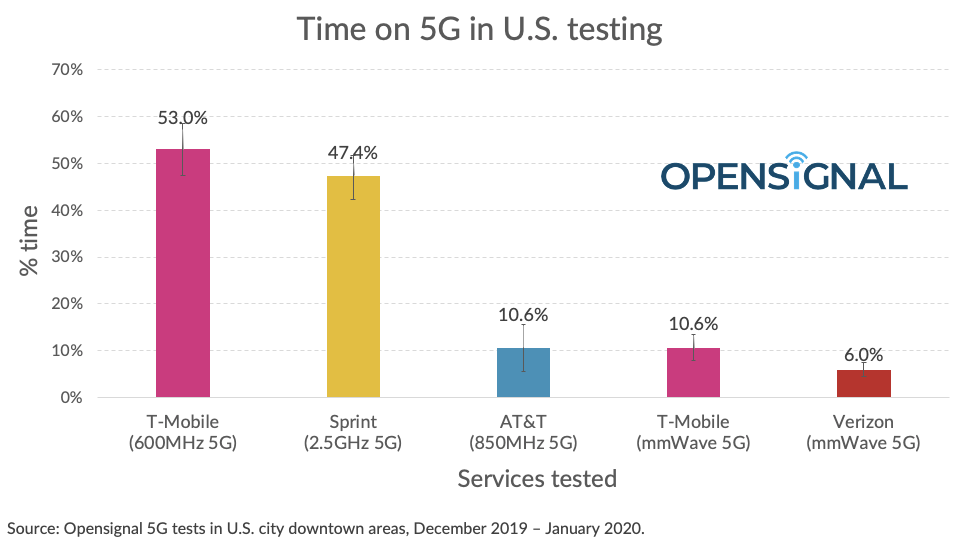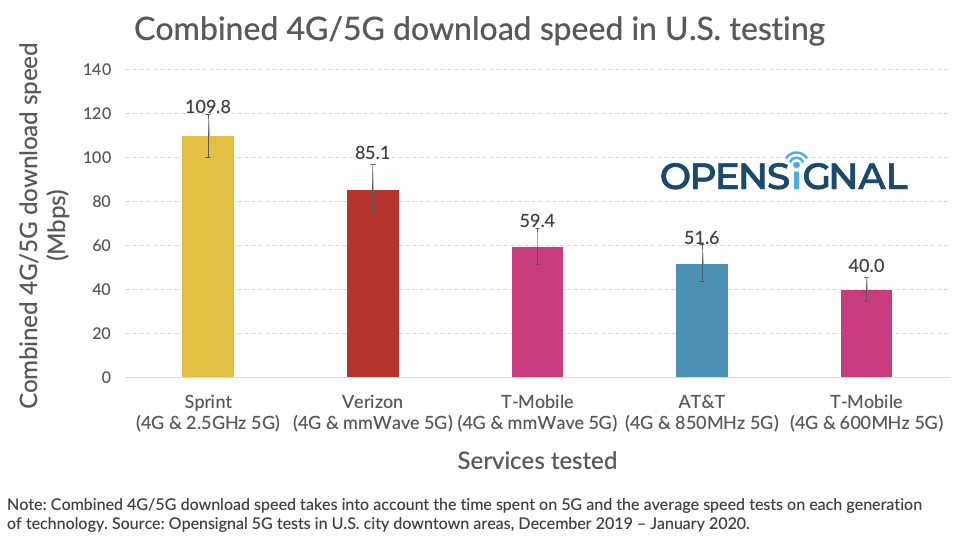Key points:
We recorded the fastest average 5G download speed of 722.9 Mbps on Verizon’s 5G network.
On T-Mobile’s 600Mhz 5G network we saw the greatest time connected to 5G of 53.0% in downtown areas of U.S. cities where 5G has launched.
Taking into account both time on 5G and average download speeds, we saw the fastest average combined 4G/5G download speeds on Sprint’s 5G network.
Users should not automatically expect speeds of several hundred Mbps on 5G. In tests we saw average 5G download speeds range from 47.5 Mbps to 722.9 Mbps.
U.S. carriers’ 5G services are held back by 5G spectrum availability. Some services are ultra fast but they offer limited reach. While others are much slower due to limited spectrum but have much better reach. U.S. carriers need the release of large chunks of mid-band spectrum to offer the best of both worlds and for 5G in the U.S. to hit its potential.
There’s lots of confusion around 5G, in part because each U.S. carrier has taken a different initial approach to 5G. Some 5G services use brand new high frequency mmWave spectrum that’s never been used for cellular before, others are re-using mid-band spectrum, while some have launched in the low-band spectrum that’s normally best for wide coverage. We explain more about these types of 5G below. As Opensignal’s previous analysis has shown with 4G, different types of spectrum offer users a very different experience. In this new analysis, we manually tested 5G in downtown areas of U.S. cities to quantify these differences.
In these tests, average 5G download speeds from Verizon were 15 times faster than the slowest 5G offering
Opensignal recorded the fastest average 5G download speed of 722.9 Mbps on Verizon’s 5G mmWave network, followed by T-Mobile’s mmWave with 243.1 Mbps, and Sprint at 183.0 Mbps on its 2.5 GHz 5G network in known locations where 5G was present. AT&T and T-Mobile’s low-band 5G networks clocked average download speeds of 59.3 Mbps and 47.5 Mbps respectively, confirming that the type of 5G service and the spectrum used for 5G has a major impact on the speeds a user will see.

We analyzed T-Mobile’s mmWave 5G service separately from its 600MHz 5G service because at the time of our testing in December and January a potential customer had to choose a 5G smartphone model that either supported mmWave 5G on T-Mobile or one that supported 600MHz 5G on T-Mobile. There was no model available that supported both. The first phone to offer that capability will be the Samsung Galaxy S20 Ultra 5G which is available from March 6 which uses a newer 5G chipset.
The speeds Opensignal found reflect U.S. operators’ different deployment strategies for their 5G networks:
mmWave high-band 5G: Verizon, T-Mobile and AT&T launched mmWave 5G networks across a number of cities, although AT&T’s service is only available to business customers and select early adopters.
Mid-band 5G: Sprint is using its mid-band 2.5 GHz for 5G and possesses enough spectrum to deliver hundreds of Mbps in speed, with a decent signal propagation. Sprint states it has citywide coverage in locations where it has launched its service.
Low-band 5G: T-Mobile and AT&T re-used 4G spectrum from their 850 MHz and 600 MHz holdings and launched 5G services using low-band spectrum in December 2019. U.S. operators have been more conservative in their speed claims for low-band 5G services, but they will offer much wider coverage when compared to high and mid-band 5G.
Devices connected to T-Mobile & Sprint’s lower-band 5G five times as often as to Verizon’s mmWave 5G
Opensignal also conducted tests around the downtown areas of cities where U.S. operators had stated they had launched their 5G services to understand how often speed tests would be on 5G. In our testing, finding a 5G signal often proved challenging.
On T-Mobile’s 600Mhz 5G network we saw the greatest time connected to 5G of 53.0%. We were able to connect to a 5G signal just over half of the time during our testing on T-Mobile’s 600 MHz and slightly less on Sprint’s 2.5GHz 5G networks. With both T-Mobile’s mmWave and AT&T’s 850 MHz 5G networks we spent 10.6% of the time connected to a 5G signal during the walk tests, while we connected to a 5G signal on Verizon’s mmWave 5G just 6% of the time.

While we expected a more limited reach of the two mmWave networks compared with other 5G services, we were surprised by the limited time spent on AT&T’s low-band 5G in our tests. Theoretically, 850MHz should possess far better reach than the high-band networks. However, AT&T’s 5G coverage maps included a note that the 5G coverage shown is “by February 2020” and we tested AT&T’s 5G shortly after AT&T started to launch their 850MHz network from December 13.
The reason for this result in our tests could be because AT&T had not yet deployed much of a 5G footprint in those cities and was still ramping to its target, or it could be because AT&T’s network would only push a phone to a 5G connection if there was an advantage in terms of experience over 4G (as stated by an AT&T spokesperson), or a mixture of both reasons.
Opensignal recorded the fastest average combined 4G/5G download speeds on Sprint’s network
In Opensignal tests we saw speeds of several hundred Mbps on 5G mmWave networks but devices found a 5G signal 10.6% or less of the time on this type of 5G, while devices connecting to low-band 5G networks found signal about half of the time but saw far slower speeds compared to high-band 5G.
We calculated a combined 4G/5G download speed taking into account how much time devices spent connected to each 5G network during the walk tests, to understand which 5G service had the biggest impact on the download speeds we observed.

Taking into account both time on 5G and average download speeds, out of the five consumer 5G services tested, only Sprint exceeded the 100 Mbps threshold in average combined 4G/5G download speed tests. Despite offering slower average 5G download speeds than mmWave, Sprint’s mid-band 5G had a much greater impact on our combined download speed — which averaged 109.8 Mbps — because we were able to connect to 5G almost half of the time.
We clocked the second fastest average 4G/5G download speed of 85.1 Mbps on Verizon’s networks. Despite measuring an average 5G download speed of 722.9 Mbps, the 5G speed impact on the combined 4G/5G download speed was much diluted because we were able to spend just 6% of the time connected to a 5G signal during our testing.
Opensignal recorded an average of 59.4 Mbps in 4G/5G download speed on T-Mobile’s network, when looking at T-Mobile’s 5G mmWave and 4G for the same smartphone model. Remember, because when we tested the services there was no single smartphone that could work on both T-Mobile’s mmWave 5G and their 600Mhz 5G we have again looked at them separately. Because we spent 10.6% of the time connected to 5G during our testing, 4G download speed played a bigger role in our combined 4G/5G download speed, despite the fact that we averaged almost 250 Mbps in 5G download speed.
AT&T and T-Mobile’s low-band 5G networks showed limited impact on the overall download speed as both reached 51.6 Mbps and 40.0 Mbps respectively — which were not far from the 4G download speeds we saw during the testing.
What these early 5G test results really mean
It’s still just the start of the 5G era, so it’s early to draw definitive conclusions on the future of 5G. But some trends are starting to show:
U.S. carriers’ 5G services are held back by 5G spectrum availability. Without the availability of new 5G mid-band spectrum, U.S. wireless operators have launched 5G services on a variety of spectrum frequencies that they had available, spanning from 600 MHz to 28 GHz. We believe that all U.S. operators will need to complement their holdings with more mid-band spectrum to take advantage of the sweet spot which 3-6 GHz frequencies provide in the trade-off between low bands’ wide reach and high bands’ super-fast speeds. At the moment, Sprint — soon the new T-Mobile when the Sprint/T-Mobile merger closes — is the only operator that owns spare mid-band spectrum that can be used for 5G.
mmWave 5G really is extremely fast. Speeds will depend on the type of 5G — low frequency band, mid-band or mmWave — and consequently on the amount of spectrum that operators have available for their 5G users. Opensignal measured how different spectrum band provides different benefits: mmWave allows for high capacity and super-fast speeds which would be advantageous in specific areas like crowded stadiums, whereas low-band 5G’s biggest benefit — its extended reach — allows for the creation of a diffused 5G coverage layer, with a limited uplift in terms of speed.
Users should not automatically expect speeds of several hundred Mbps on 5G. All of the 5G speeds we see are fast by U.S. standards, but seeing a 5G icon on the screen is no guarantee of 5G, or of speeds of hundreds of Mbps, instead real-world testing at scale will be needed to quantify the true 5G experience. Users need to look at the real-world 5G experience of each operator to understand what 5G means.
However, it’s hard to extrapolate from these initial tests of 5G to the long-term experience because of the experimental and early nature of U.S. 5G. These tests are the results of a series of manual tests as part of Opensignal’s research and development program and provide an early indication of the capabilities of different approaches to 5G. In our regular country reports, we routinely collect billions of measurements using automated tests from millions of devices in the U.S. alone and which reveal the true real-world mobile network experience at scale.
The 5G future
Today, we are seeing only a preview of what the full 5G experience will look like in the coming years. In 2020, as smartphone makers start to make 5G the default option on their phones, 5G adoption will accelerate as users will not need to opt-in for 5G capabilities.
While speeds on low-band 5G services are relatively low compared to mid and high-band 5G, in the future there will be other benefits to 5G that will be possible on these bands beyond speed. Most notable, will be improved latency — a measure of network responsiveness — which will boost the experience of playing multiplayer games which Opensignal is already analyzing, see The State of Mobile Games Experience in the 5G Era. But for now, with these non-standalone access (NSA) services, we found no significant improvement in 5G latency over 4G.
The technology still has a long way to go: mobile operators are aiming to introduce Dynamic Spectrum Sharing (DSS) later this year — which will enable carriers to deploy both 4G and 5G in the same spectrum band and dynamically allocate that spectrum between the two technologies as needed. We also expect to see U.S. operators move to standalone (SA) 5G, which will bring ultra-low latency and unlock new use cases for mobile technology.
More and more consumers will start using 5G networks and upcoming U.S. auctions will offer new spectrum. All in all, 5G mobile experience will most likely be very different in the future and Opensignal will be tracking 5G in future reports.
Opensignal Limited retains ownership of this insight including all intellectual property rights, data, content, graphs & analysis. Reports and insights produced by Opensignal Limited may not be quoted, reproduced, distributed, published for any commercial purpose (including use in advertisements or other promotional content) without prior written consent. Journalists are encouraged to quote information included in Opensignal reports and insights provided they include clear source attribution. For more information, contact [email protected].
